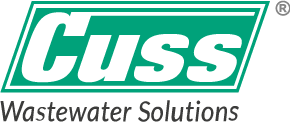Aeration systems
Membrane pressure aerators
Membrane pressure diffusers force air into the reactor through membrane modules located at the bottom of the tank. The air is introduced evenly and over a wide area. Small bubble sizes can be achieved through the membrane, which optimises the oxygen input into the wastewater. In addition, the air input can be controlled by adjustable blowers. Membrane pressure aerators are not only scalable, but are also among the most powerful aeration systems and are therefore often installed.
Such systems can also consist of modules equipped with a lifting device. Such liftable aeration systems allow maintenance during operation, but are more expensive to purchase.
Submersible aerators
With this technique, a motor is attached to the bottom of the pool to be aerated. This motor draws in air from the surface via a pipe and distributes it to the underside of the pool. Because it is a point aeration, the efficiency of a single submersible aerator is limited. In systems where aeration is critical to the process (e.g. aerobic treatment in the activated sludge tank), other systems are therefore preferred. However, because they are inexpensive to purchase and operate reliably with low maintenance, submersible aerators are suitable for pre-aeration in the equalisation basin or sludge aeration to prevent unpleasant odours.
Surface aerators
With surface aerators, the wastewater is continuously stirred up and sprayed at the surface. This results in large contact areas between the wastewater and the ambient air. This type of aeration is one of the oldest and most tried and tested. Compared to other aeration systems, however, there are considerable noise and aerosol emissions.

